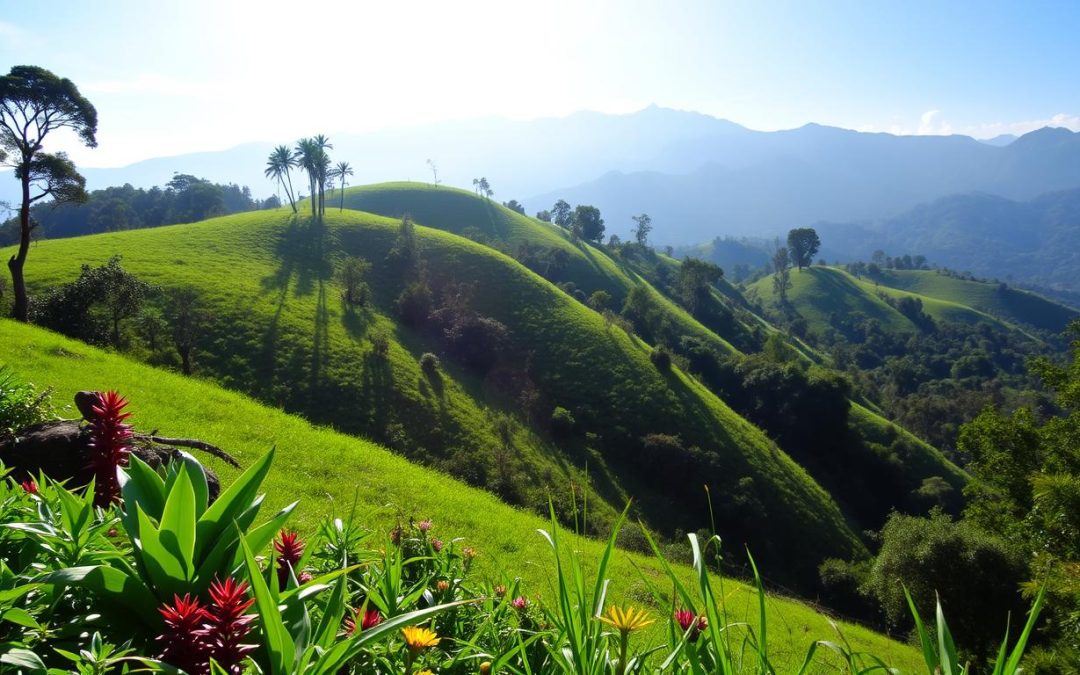Are you ready to explore a hidden Caribbean paradise? Macaya National Park in Haiti is a secret gem for nature lovers and brave explorers. It’s a place that few travelers know about.
This amazing park covers 8,500 hectares of stunning wilderness. It has everything from cloud forests to high mountains. You can see over 600 plant species and 155 bird species here. It’s a journey into the Caribbean’s most untouched nature.
Imagine being at the top of Pic Macaya, at 2,347 meters. You’re surrounded by beautiful landscapes that few have seen. The park offers tough hikes and chances to see amazing wildlife. It’s an adventure waiting for you.
Key Takeaways
- Explore one of Haiti’s largest protected natural areas
- Discover unique biodiversity with 600+ plant species
- Experience world-class hiking at Pic Macaya
- Witness rare bird species in their natural habitat
- Immerse yourself in unspoiled Caribbean wilderness
- Support local conservation efforts
Overview of Macaya National Park: Haiti’s Natural Treasure
Macaya National Park is in the heart of Haiti. It’s a stunning place filled with Haitian biodiversity. Visitors get to see one of the Caribbean’s most unique ecosystems.
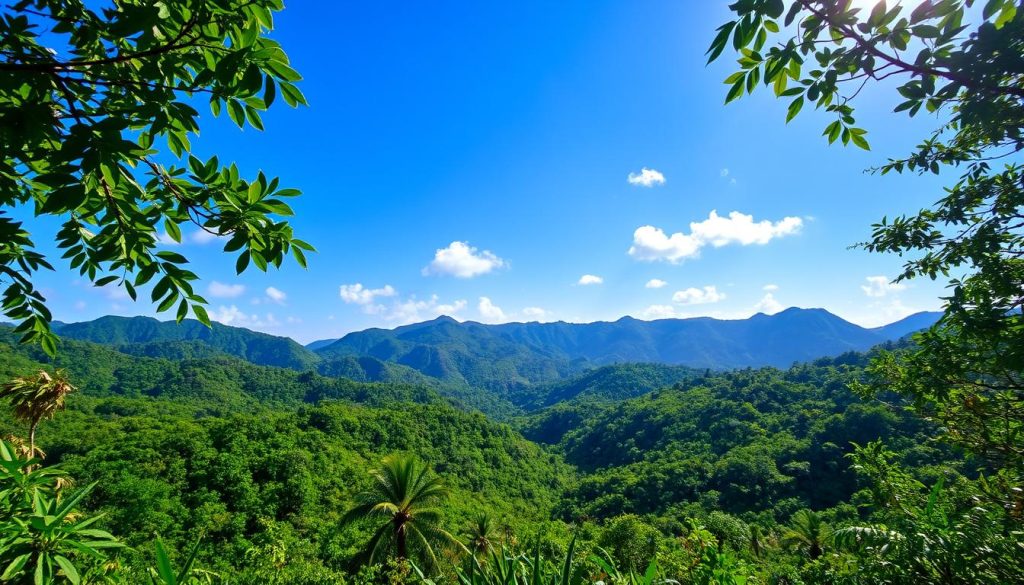
Location and Park History
Macaya National Park is in Haiti’s southwestern mountains. It’s a key part of a protected area network. The park has steep mountains, dense forests, and high-altitude ecosystems.
UNESCO Biosphere Reserve Status
The Macaya Biosphere Reserve is a big step for environmental protection. It’s a UNESCO site, protecting Haiti’s rare species. This status helps protect nature while supporting people.
Geographical Features and Climate
The park has a tropical climate, with temperatures around 80°F. It has rainy seasons from April to June and October to November. This makes it perfect for biodiversity.
“Macaya National Park is a testament to Haiti’s natural wealth and ecological significance.”
The park’s landscape is diverse. It has high peaks, lush cloud forests, and different climates. This supports a wide range of wildlife.
Visiting this park is an unforgettable experience. It’s a chance to see one of Haiti’s most valuable natural treasures.
Exploring Biodiversity: Endemic Species and Wildlife
Macaya National Park is a special place for Haitian endemic species. It protects unique wildlife in the Caribbean rainforest. The park’s ecosystem is home to creatures found only here, making it vital for preserving biodiversity.
Exploring this natural wonder, you’ll meet amazing animals. The Hispaniolan Solenodon, a rare mammal with venom, lives here. You’ll also see Hutia species, small rodents that show the park’s rich wildlife diversity.
“Biodiversity is the key to understanding the intricate web of life in Macaya National Park.” – Caribbean Conservation Expert
- Hispaniolan Solenodon: A prehistoric mammal unique to Haiti
- Endemic Hutia species: Small rodents with restricted geographic range
- Rare bird populations: Critical for Caribbean ecosystem balance
The park’s importance goes beyond its species. It’s a key part of Caribbean rainforest conservation. Protecting it helps keep the ecosystem balanced and supports these incredible creatures.
| Endemic Species | Conservation Status | Unique Characteristics |
|---|---|---|
| Hispaniolan Solenodon | Critically Endangered | Venomous mammal, ancient lineage |
| Hutia | Vulnerable | Endemic rodent species |
| Rare Bird Species | Various | Restricted geographical distribution |
By protecting Macaya National Park, you help save these unique Haitian endemic species. You also support efforts to preserve the Caribbean rainforest. Every visitor is crucial in keeping this biodiversity hotspot safe.
Hiking Trails and Summit Adventures
In the heart of Haiti, the Hispaniola hiking trails await. They offer an unmatched experience through stunning landscapes. Macaya National Park is a chance to see some of the Caribbean’s most untouched wilderness.
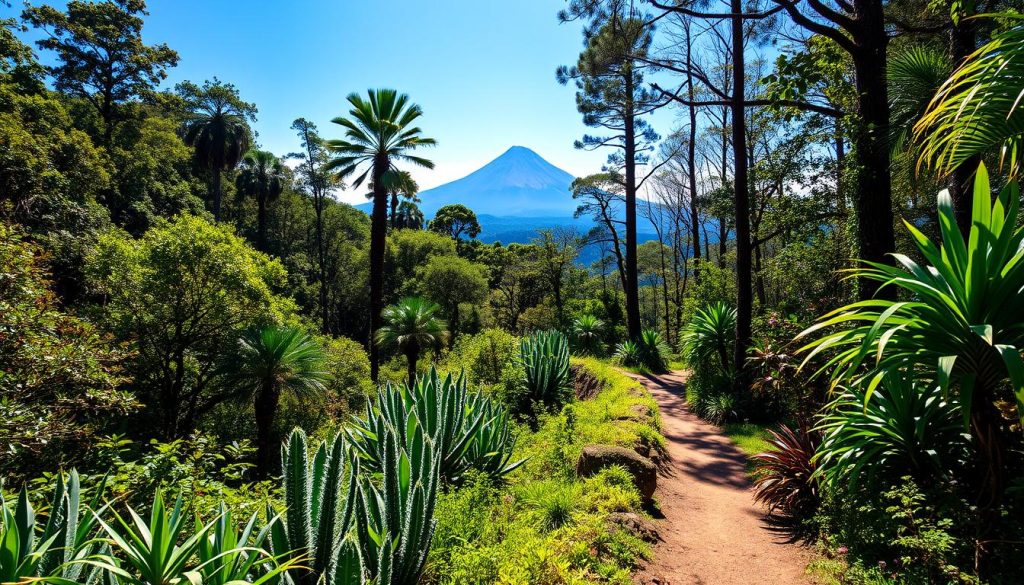
The Pic Macaya summit, at 2,347 meters, calls to hikers. Its trails are challenging but rewarding. Your adventure here will be unforgettable.
Pic Macaya Summit Trail
Get ready for an exciting hike through different ecosystems. The summit trail offers:
- Stunning panoramic views of the surrounding mountain ranges
- Challenging terrain for experienced hikers
- Opportunities to spot rare endemic species
- Elevation gains that test your physical endurance
Cloud Forest Exploration Routes
Exploring the cloud forests is a must on your Hispaniola hiking trails. These routes take you into a world of misty landscapes and incredible biodiversity.
Safety Tips for Hikers
Before you start your Pic Macaya summit adventure, remember these safety tips:
- Carry enough water and high-energy snacks
- Wear sturdy hiking boots with good ankle support
- Check the weather before you start
- Bring a first-aid kit and emergency communication device
- Hire a local guide who knows the terrain
“The mountains are calling, and I must go.” – John Muir
Whether you’re a seasoned trekker or just love nature, the Hispaniola hiking trails at Macaya National Park are extraordinary. They offer a journey through Haiti’s breathtaking natural beauty.
Macaya National Park, Haiti: Best Things to Do – Top Picks
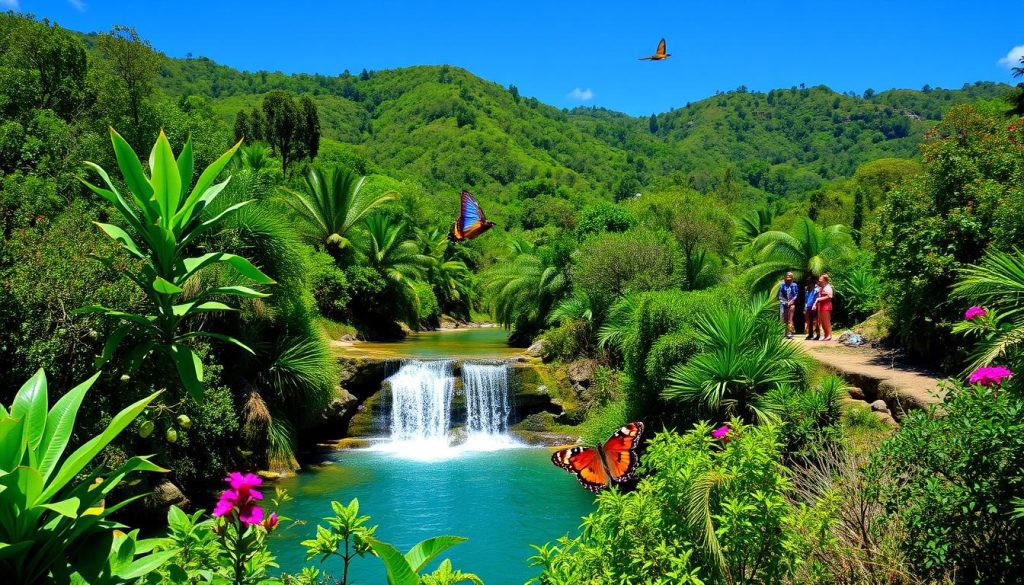
Explore the ultimate adventure in Haiti’s natural wonderland! Macaya National Park is a treasure trove of experiences for nature lovers and adventure seekers. Your trip here will leave you with memories and encounters with unique wildlife that you’ll never forget.
Here are the top things to do in Macaya National Park:
- Hiking Pic Macaya Summit: Challenge yourself with an exhilarating trek to the park’s highest peak, offering panoramic views of Haiti’s stunning landscape
- Birdwatching Expedition: Spot rare endemic species in their natural habitat, with peak observation times during the dry season (December to April)
- Cloud Forest Exploration: Immerse yourself in the lush, misty ecosystem unique to Macaya National Park
- Photography Safari: Capture incredible moments of biodiversity and stunning natural scenery
For the best experience in this remarkable Haiti national park, plan your visit during the dry season. Temperatures then range from 25°C to 30°C. Wear light, quick-dry clothing and bring sturdy hiking boots for the diverse trails.
“Macaya National Park is not just a destination, it’s a journey into the heart of Haiti’s natural beauty.” – Local Ecotourism Guide
Practical tips for your Macaya adventure include booking your trip about three months in advance. Make sure your passport is valid for at least six months beyond your return date. Also, check vaccination requirements based on your age and origin country.
Birdwatching Paradise: Rare Species Spotting
Macaya National Park is a haven for bird lovers. It’s home to over 300 bird species. This place offers a unique birdwatching experience for all.
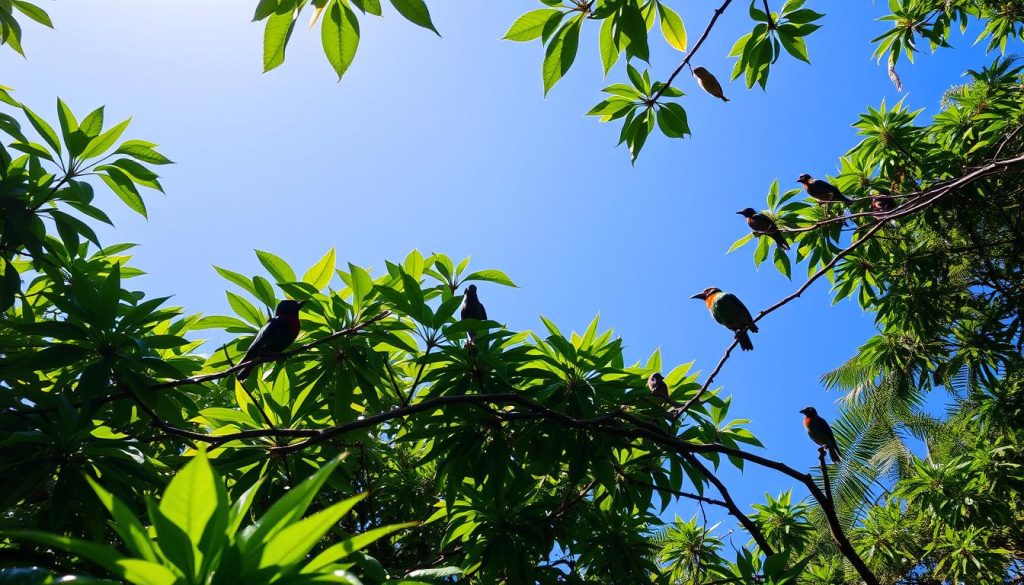
Best Seasons for Birdwatching
The best time for birdwatching is from November to April. This is when birds migrate and breed. You’ll see amazing bird activities in the park’s different areas.
- Peak migration period: November-April
- Most active bird breeding season: March-May
- Recommended early morning observation times: 6:00 AM – 9:00 AM
Notable Bird Species
Macaya National Park is home to unique birds. You’ll see the Narrow-Billed Tody and the Hispaniolan Trogon, Haiti’s national bird.
| Species | Unique Characteristics | Habitat Preference |
|---|---|---|
| Hispaniolan Trogon | National bird of Haiti | Cloud forest regions |
| Narrow-Billed Tody | Vibrant green and red plumage | Humid forest understory |
| Haitian Gnatcatcher | Endemic to Hispaniola | Dry forest zones |
Photography Tips
To capture rare birds, you need patience and the right gear. Use a telephoto lens, silent camera modes, and wear neutral colors. This helps you blend in with the rainforest.
“In Macaya, every feathered moment is a treasure waiting to be discovered.” – Local Ornithologist
Conservation Efforts and Ecological Importance
Macaya National Park is a key spot for saving the Caribbean rainforest. It fights against Haiti’s big environmental problems. With only 1% of Haiti’s forests left, the park is a crucial place for saving nature and fixing the environment.
- Protecting over 150 unique plant species
- Stopping soil erosion that affects 80% of Haitian lands
- Helping local communities through green tourism
- Keeping safe homes for endangered animals like the black-capped petrel
“Conservation is not just about protecting nature, but about sustaining the delicate balance between human needs and ecological preservation.”
New ways are needed to tackle environmental problems. Local people are now helping with conservation, seeing it as a way to keep their economy strong. By starting green tourism, the park helps the economy and keeps the rainforest safe.
Important conservation plans include:
- Lowering deforestation rates
- Starting green farming
- Creating jobs for local people
- Watching over special species
Visiting Macaya National Park helps these important conservation efforts. It turns tourism into a strong force for protecting the environment and helping communities.
Planning Your Visit: Practical Information
Getting ready for your trip to Macaya National Park in Haiti is key. This guide will cover the basics of visiting one of Haiti’s top national parks.
Best Time to Visit
When you go can greatly affect your experience. The best times to visit depend on what you want to do:
- Dry Season (November to March):
- Great for hiking and seeing wildlife
- Trails are clearer and easier to see
- Less rain means fewer disruptions
- Rainy Season (April to October):
- Vegetation is lush and landscapes are vibrant
- Perfect for photos
- Hiking can be tougher
Transportation Options
Getting to Macaya National Park needs some thought:
- Organized Tour Groups
- Best way to get there
- Includes a local guide
- Takes care of park entry
- Private Transportation
- 4×4 vehicles are best
- Need a driver who knows the area
- More flexible with your schedule
Accommodation Choices
Staying near Macaya National Park offers various options:
| Accommodation Type | Pros | Considerations |
|---|---|---|
| Eco-Lodges | Sustainable, Close to park, Local experience | Limited amenities, Basic facilities |
| Camping | Immersive nature experience, Low cost | Requires own equipment, Challenging terrain |
| Nearby Town Guesthouses | More comfort, Easier access | Further from park entrance, Higher cost |
Pro Tip: Always check current park conditions and local travel advisories before your trip to Haiti’s national parks.
Good planning makes your Haitian ecotourism trip unforgettable!
Cultural Significance and Local Communities
Macaya National Park is more than just a beautiful place. It shows Haiti’s rich culture, blending nature and traditions. The local people around the park live in harmony with it, keeping both nature and culture alive.
The park’s story is one of strength. People near Macaya have learned from their ancestors. They live in balance with nature, helping protect the park.
“Our forest is our life, our history, our future,” says a local elder from a nearby village.
- Traditional agricultural practices that protect forest boundaries
- Sustainable hunting and gathering techniques
- Cultural festivals celebrating local biodiversity
- Artisanal crafts inspired by native flora and fauna
Haitian ecotourism helps local communities. It gives them a chance to make money while protecting the park. Local guides share their knowledge with visitors, helping the park and culture.
| Community Activity | Conservation Impact |
|---|---|
| Guided Nature Tours | Reduces illegal logging |
| Traditional Handicrafts | Creates alternative income sources |
| Environmental Education | Builds local ecological awareness |
Visiting Macaya National Park is more than fun. It’s a chance to see Haiti’s culture and nature. Every path has a story of survival, respect, and deep wisdom.
Conclusion
Macaya National Park is a stunning place for those who love nature. It’s more than a vacation; it’s a chance to see the Caribbean’s most diverse nature. By visiting, you help protect Haiti’s wildlife and support local people.
The park’s beauty and wildlife make it a top spot for nature lovers. Your trip helps protect animals and boosts the local economy. Whether you love nature, photography, or adventure, Macaya offers an experience you’ll never forget.
Haiti is growing its tourism, and Macaya National Park is a key part of that. Your visit creates memories and supports eco-friendly travel. It’s a chance to see Haiti’s amazing nature and help its tourism grow.
Get ready to be amazed by Macaya National Park’s wonders. It’s a hidden treasure waiting for you. Your journey will open your eyes to Haiti’s potential for green tourism and conservation.
The above is subject to change.
Check back often to TRAVEL.COM for the latest travel tips and deals.
